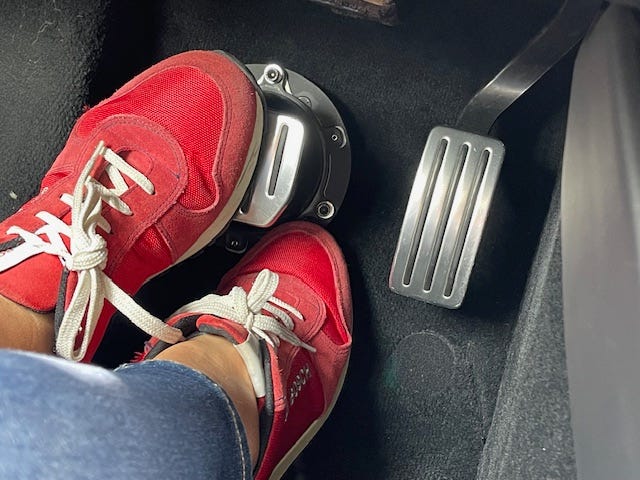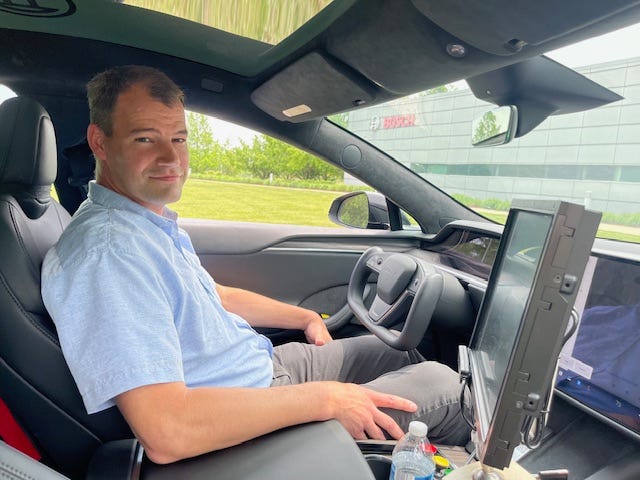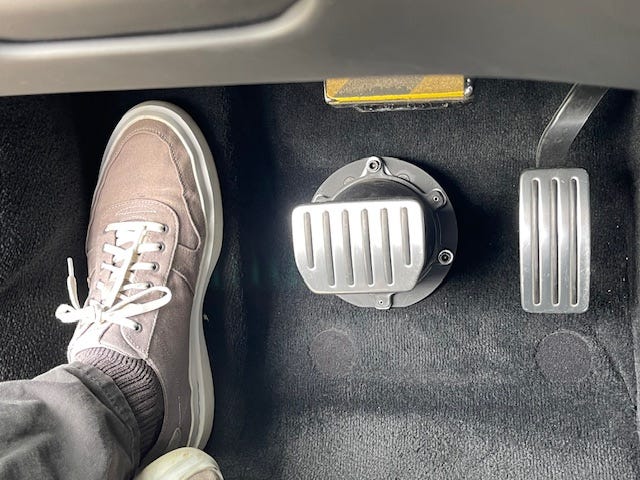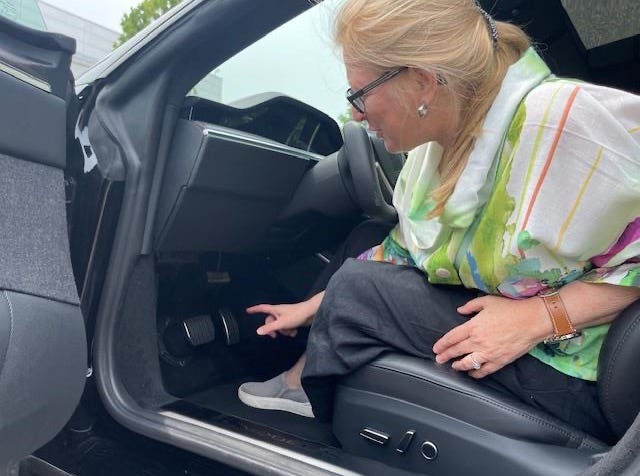Shoe choice won't affect braking now
Latest tech changes how car brakes work, eliminating concern about interference
Few drivers think about how they use a brake pedal to stop a vehicle — despite doing so more than a million times a year on average, according to national highway traffic safety officials.
That is, unless there’s a problem:
A flip-flop gets caught under the brake pedal. (Happened to me.)
A water bottle rolls under the brake pedal. (Happened to me.)
A phone slides from console under the brake pedal. (Happened to me.)
A floor mat jams under the brake pedal. (Happened to me.)
Yet not one scenario above will affect the new brake system designed by Bosch that uses brake-by-wire technology. Production is scheduled for later this year.
The new brake design creates space below the brake pedal that can accommodate a shoe, crumpled carpet, a fallen cell phone. A driver could rest their foot under the brake pedal with zero impact.

How it works: The actual brake pedal doesn’t move. Braking is caused by pressure applied to a pad on the surface of the brake pedal that a driver presses with their foot to trigger sensors. The sensors tell the vehicle to stop. The system is decoupled from actually squeezing the brake pads against the rotors.
As a result, the stop is smoother and more responsive — less jerky.
“The driver can choose to give passengers a limo stop every time,” said Brad Lobbestael, 46, a Bosch system development engineer from Howell, Mich. He drove with me in a Tesla to demonstrate the brake-by-wire prototype at the Plymouth headquarters.
“With by-wire braking, you don’t have a physical connection” to the brakes anymore, he said.
There is no mechanical connection between the driver and the brakes.

The driver still presses the pedal, but it’s effectively a remote control, said Sam Abuelsamid, vice president of market research at Telemetry Agency, who spent more than two decades as an engineer in the automotive industry.
In this brake-by-wire system, backup safety to the e-pedal is provided by the existence of two brake actuators, the parts of the system that distribute the proper amount of brake fluid to each wheel.
The Bosch brake system has a hydraulic element that still uses brake calipers that house the brake pads, so pressing the top of the brake pedal triggers sensors that tell the software to push brake fluid to the brake pads, which squeeze against those metal discs connected to the tire's hub known as rotors.
The company is capable of making a brake more or less responsive, requiring drivers to press harder. It can cater to consumer desires for feel but the hydraulic system is software controlled based on sensor inputs. The pedal doesn’t travel.

This system is another step toward autonomous driving, and it also makes manufacturing easier for automakers building globally with steering wheels on different sides of the vehicle.
Brake by wire is a term that’s “been coming in a few years” for over a decade now, said Beth Bond, 39, of Commerce, Mich., director of marketing and communications at Bosch Mobility.
The company declined to disclose which client is adopting this technology but this initial client will use it for an electric vehicle, she said.
“This has a faster response time,” Bond said. “The traditional brake (pedal) — you have to push and it has to travel.”

Brakes may one day be controlled by electricity without brake fluid, but not yet, Bond said.
Abuelsamid told me pedals and space in a vehicle’s footwell have been studied by engineers for decades.
“Brake by wire, as a broad term, is old tech. But this is an evolution of what car companies have been doing for 30 years,” he said.
By separating the direct pedal linkage, braking is going to be more consistent, Abuelsamid said. “You’ve taken away the human redundancy and you’re relying entirely on this electro-hydraulic system to generate that brake pressure. As we move toward a fully automated system, you can eliminate the pedal sensor entirely.”

Shoe choice has created so many challenges for drivers over the years that a lucrative industry of modern “driving” shoes surfaced for men and women, initially patterned after thin and flexible soles made for race car drivers.
Eric Noble, professor of vehicle technology at ArtCenter College of Design in Pasadena, Calif., consults with top auto companies. He worked with German engineers trying to understand car footwells and what consumers wear.
“We made all the engineers go get pedicures, have their nails painted, then have spreaders put on their feet while they wore those little temporary flip flops. Then we had them go back to the mini vans and drive off,” Noble said. “We wanted them to understand what they needed to accommodate.”
For the record, driving in paper-thin flip-flops after a pedicure is terrifying.
Shoe designer Aki Choklat, chair of the fashion design department at the College for Creative Studies in Detroit and author of “Footwear Design” (Lawrence King Publishing, 2012), said footwear companies do consider vehicle design and the space involving foot pedals when driving.
“I didn’t know there was a new kind of braking system coming,” he said. “This is an exciting development. It’s not something I actually thought of before.”
Tom Carbone, a product engineer at Chrysler for 30 years, said changing the gas pedal to wire control triggered “great fear” a decade ago and now no one thinks anything about it.
“This is how the auto industry creeps up on new technology,” he said.
PS: As a proud member of the Iowa Writers’ Collaborative, a roundup of world-class journalists, I hope you’ll check out the incredible news, commentary and features.




Phoebe, this is a really interesting and super awesome automotive article. I posted it on my FaceBook page!
I am guessing this also has an application for cars that are driven by people who require hand controls only (cannot use their legs). But maybe these controls for the brakes are already electronic?